Comprehensive Guide to Gem Faceting Techniques
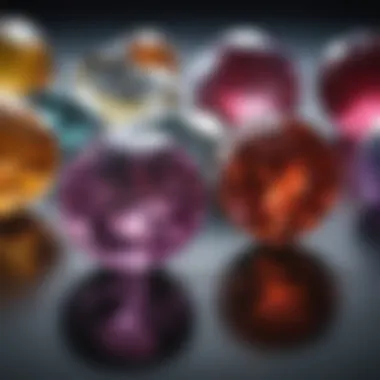
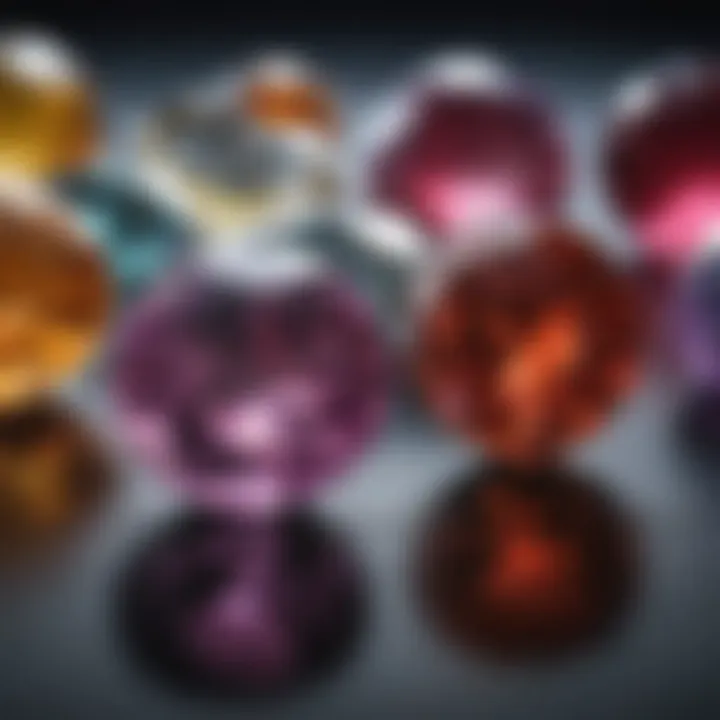
Intro
Gem faceting is more than just a craft; it is an art form that transforms raw stones into radiant masterpieces. When one considers the intricate world of gem faceting, it becomes clear that a deeper understanding of gemstones is crucial to mastering this complex technique. Whether you're a seasoned gemologist or just a curious enthusiast, the nuances of faceting open a gateway to appreciating the beauty and science of gemstones.
In this guide, we will explore various aspects of gem faceting classes. From the foundational knowledge of what gemstones are to the specifics of faceting techniques, tools, and educational resources, this guide aims to provide a comprehensive look into the subject. We will also touch upon historical insights and emerging trends in gem faceting that can influence both hobbyists and professionals alike.
Gemstone Overview
Definition and Characteristics
Gemstones are naturally occurring minerals or organic materials that, after being cut and polished, are used for decorative purposes in jewelry and other adornments. They often exhibit unique characteristics that make them desirable:
- Rarity: Some gemstones are far less common than others, which can drive their value.
- Color: Gemstones come in a wide spectrum of colors, and often, the hue can enhance emotional appeal.
- Clarity: The presence of inclusions can impact the overall beauty and, consequently, the value of a gemstone.
- Cut: This refers to how well a gem has been shaped and polished, influencing its reflection of light.
Classification of Gemstones
Gemstones can be broadly classified into two categories: precious and semi-precious. This classification often depends on rarity, beauty, and overall desirability.
- Precious gemstones: These are the marquee players in the gemstone world. Diamonds, rubies, sapphires, and emeralds make the cut in this elite group.
- Semi-precious gemstones: While they may not have the same market value as the precious ones, they still possess unique attributes. Examples include amethyst, garnet, turquoise, and opal.
Properties of Gemstones
Physical Properties
Understanding the physical properties of gemstones is vitally important in the art of faceting. These include:
- Hardness: Measured on the Mohs scale, this property helps identify how resistant a gemstone is to scratching.
- Luster: This describes how light interacts with the surface of a gemstone, which can significantly impact its visual appeal.
- Birefringence: It refers to the double refraction of light, which can create unique optical effects.
Chemical Properties
The chemical composition of a gemstone determines much about its characteristics. For example:
- Silica: Found in quartz and other gemstones, its presence often indicates hardness and clarity.
- Aluminium: In ruby and sapphire, aluminum combined with oxygen and other elements results in vibrant colors.
In order to dive deeper into gemology and begin the journey of faceting, having a solid understanding of these properties helps. This knowledge can aid in selecting suitable stones and applying the right techniques during the faceting process.
"Understanding the intrinsic nature of gemstones not only enriches the crafting process but also elevates the art of jewelry design."
As we proceed through this guide, readers can expect to gain a wealth of information that encompasses everything from the technical aspects of faceting to the aesthetic enjoyment of beautifully crafted gemstones.
Prologue to Gem Faceting
Gem faceting is a delicate art, a melding of scientific precision and artistic expression. As gemstones make their way from the earth to the jeweler’s display case, how they’re cut can drastically affect not only their beauty but also their market value. Each facet of a gem acts like a little mirror, reflecting light in a way that enhances its brilliance. In this section, we will explore the fundamental aspects of gem faceting, laying the groundwork for understanding its significance in the larger realm of gemstone craftsmanship.
Understanding the nuances of gem faceting is essential for anyone looking to delve deeper into gemology. It isn’t just about creating prettier stones; it’s about mastering techniques that can elevate an ordinary piece of mineral into an extraordinary work of art. The language of light plays a crucial role here, as skilled faceters learn to manipulate it. Having a firm grasp of the basics is the cornerstone for anyone aspiring to become a facet master.
Understanding Faceting Basics
To put it simply, faceting refers to the process of cutting a gemstone in particular geometrical shapes, enhancing not just its curvature but also its reflective qualities. The intricacies involved in this craft can seem daunting at first, but breaking it down reveals its elegant complexity.
The basic tools for faceting include:
- Faceting machine: This is the cornerstone of the workspace. Essentially a high-precision setup, it allows the cutter to rotate the stone while controlling the angle of the cut.
- Grinders: Used mainly for bulk removal of stone material before refining the surface with finer tools.
- Polishing tools: After cutting, polishing tools give the gem its final shine, ensuring clarity.
Each facet is meticulously planned. The angles, their widths, and the overall design make a significant difference in how light interacts with the stone. For instance, the famous "Round Brilliant" cut has 58 facets, maximized for light return and brilliance. In contrast, an "Emerald" cut, with its step-cut design, focuses more on clarity rather than sparkle.
In learning these basics, crafting one’s style begins with proficiency in each cut type. One can’t rush this foundational training; the time spent here pays dividends when one starts to experiment and innovate.
The Role of Faceting in Gemstone Value
The way a gem is faceted embodies much more than mere aesthetics; it plays a pivotal role in determining its overall value. A poorly cut diamond, for instance, could be virtually indistinguishable from a well-cut one to the layperson, but to the trained eye, the differences are glaring.
Key factors that influence the gemstone’s value through faceting include:
- Brilliance: How effectively a stone returns light to the viewer. Better cutting means higher brilliance.
- Symmetry: Facets that are evenly shaped and positioned enhance desirability. As the saying goes, “a well-faceted gem tells its tale clearer.”
- Proportions: Each cut has ideal proportions to maximize beauty. Deviating from these can diminish a stone's appeal.
"Good faceting is the bridge between a stone's raw beauty and its final value."
In essence, a gemstone isn't just a mineral; it transforms into a work of art, deserving of appreciation. The fine line that separates an exquisite gem from an ordinary one often resides in the skill of its faceter. Thus, understanding faceting opens up not just a world of techniques but of evaluation as well, enhancing the gemologist’s toolbox.
Historical Background of Gem Faceting
Understanding the historical context of gem faceting is pivotal for anyone who aspires to delve deeper into this artisanal practice. The evolution of gem faceting not only reflects the technical advancements in the field but also encompasses cultural shifts, economic changes, and the pursuit of artistry inherent in human nature. By exploring the past, gem enthusiasts and collectors can appreciate not just the skill involved, but also the stories each cut gem conveys through its design and craftsmanship.
Ancient Techniques and Practices
Gem faceting can trace its roots back to ancient civilizations, where the first attempts at cutting gemstones were motivated by the desire to enhance their beauty. Early methods were rudimentary at best. For instance, the ancient Egyptians primarily crafted cabochons or polished stones with a rounded, smooth surface. These techniques were not merely for aesthetic enhancement; they carried significant symbolic importance. Gems like lapis lazuli were often used in religious artifacts and jewelry, signifying divinity or power.
As we move through history, we encounter the Greeks and Romans, who introduced more sophisticated cutting techniques. The Greeks pioneered the concept of geometrical faceting, creating simple facets to enhance a stone's brilliance and fire. This period marked a shift from mere polishing to the intentional structuring of angles to manipulate light. The Romans, in their conquest, spread this knowledge, integrating it into their own jewel-making traditions, which played a huge role in the popularization of facets across Europe.
However, true advancements didn't come until later during the Renaissance. Artisans began to experiment with multiple facets, which allowed for the refraction of light in ways that were never seen before. For example, the introduction of the Rose Cut revolutionized how light interacts with stones. While these ancient methods varied, they laid the groundwork for contemporary faceting, showing how time-honored techniques can still influence modern standards.
Evolution of Faceting Tools
The tools used for gem faceting have undergone significant evolution, paralleling advancements in technology and artistry. In the early days, gem cutters relied on simple hand tools made from stone, metal, or even wooden instruments. Over centuries, as the craft became more refined, so too did the tools of the trade.
During the Middle Ages, the introduction of drill-powered tools allowed gem cutters to create more precise cuts. However, it wasn’t until the 18th century that the mechanization of faceting truly began. Innovations like the faceting machine emerged, incorporating a rotating lap and adjustable arms. This allowed for much higher precision than ever before.
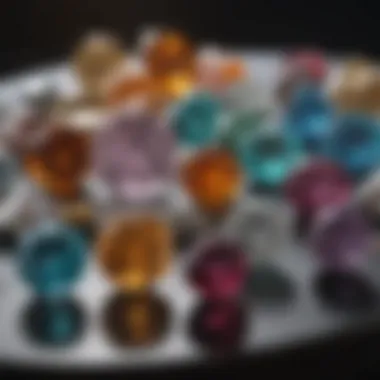
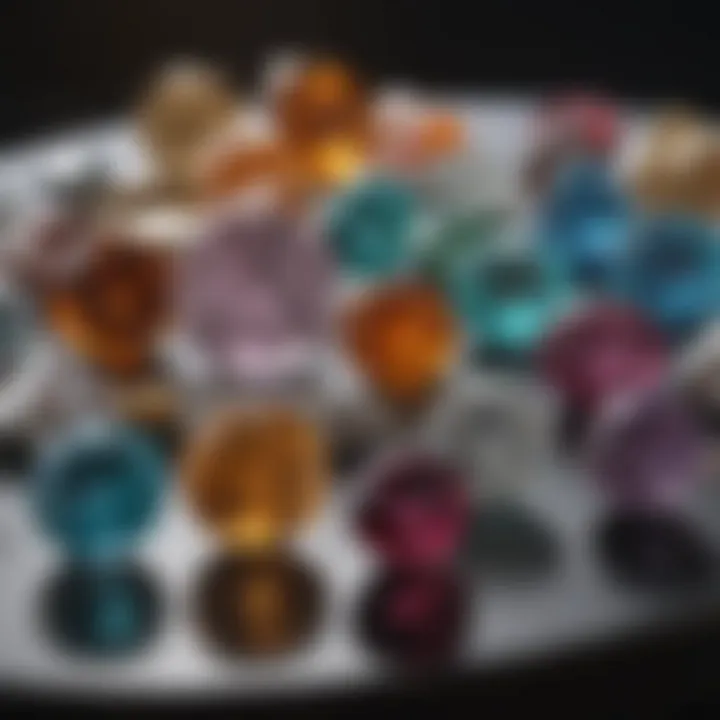
In the 20th century, the development of diamond-tipped cutting tools further propelled the industry. These tools enabled artists to craft intricate designs with unparalleled accuracy. Today, modern faceting machines bring together technology with traditional craftsmanship, facilitating a fusion of automatic and manual techniques; this helps both beginners and seasoned experts alike.
The progression of faceting tools reflects not just an improvement in efficiency but also a commitment to the art form itself. It illustrates a blend of science and craft, further enhancing the value of faceted gemstones in jewelry and collecting.
"A gem's faceting is more than just aesthetic; it’s a rich tapestry woven from cultural heritage and technological progress."
From ancient polishing to high-tech machinery, each phase is a testament to the evolving artistry of gem faceting. The historical journey of these techniques teaches aspiring gemologists the importance of skill and technology in crafting gems that not only dazzle the eye but also resonate with historical significance.
Essential Tools for Gem Faceting
Gem faceting is not just an art; it demands precision, skill, and the right tools. The essential tools for gem faceting play a pivotal role in transforming rough stones into sparkling masterpieces. Each tool is designed to serve a specific purpose, ensuring that every facet is cut with accuracy and care. Without these tools, the process can become cumbersome and the quality of the finished product can suffer. Thus, understanding these tools is crucial for both novice and experienced faceters alike.
Faceting Machines Explained
Faceting machines are at the heart of any gem faceting endeavor. They’re engineered to provide stability and repeatability in the cutting process. A well-constructed machine ensures that the angles are precise, which is essential for optimizing the stone's light performance. In essence, these machines allow one to manipulate the rough stone while maintaining control over the cutting angle, which directly impacts the final appearance of the gem.
When shopping for a faceting machine, consider the following factors:
- Stability: The machine should hold the stone securely without any wobble.
- Ease of Adjustment: Look for machines that allow you to fine-tune the angles easily.
- Accessories: Many machines come with additional tools, like angle dials and indexing systems, which can be valuable as your skills grow.
In addition, brands such as GemMaster and Ultra Tec offer reliable models that are highly regarded in the industry. Depending on your budget and skills, investing in a decent faceting machine can make a world of difference in your crafting experience. In general, one's output quality will be a reflection of the tools used, so it’s worth getting it right from the start.
Grinders and Polishing Tools
The second tier of essential tools for gemstone faceting involves grinders and polishing tools. Grinders are utilized after the initial cutting process to refine the shape and contour of the gem. They help remove any irregularities that might have occurred during the facet cutting. High-quality grinders often have different grit levels, allowing for a progressive refinement. Starting with a coarse grit and advancing to a finer one can help achieve a smooth finish. It’s akin to sculpting; each pass should reveal a clearer image until you reach the desired effect.
After grinding comes the polishing stage. This is where the real magic happens. Polishing tools come in many forms, including disks mounted on a polishing machine or handheld options for more intricate designs. The objective here is to enhance the surface quality of the gem, making it sparkle and shine brightly. Some well-known polishing materials include Diamond Polishing Pastes and Cerium Oxide.
Having the correct combination of grinders and polishing tools makes the difference between a dull, lifeless stone and one that catches the eye instantly. Polishing takes practice, often requiring multiple attempts to get the perfect sheen.
"A well-faceted gem is not just a product of skill but a symbiosis of proper tools and techniques. Each tool plays its part in narrating the gem's story."
Techniques in Gem Faceting
The art of gem faceting is not just a craft; it’s a science that intertwines precision and creativity. Techniques in gem faceting play a pivotal role in the overall quality of the gemstone and determine its aesthetic appeal. This section dives into the core facets — pun intended — of basic cuts and advanced skills, empowering both novices and seasoned faceters to harness their potential.
Basic Cuts and Their Applications
When starting on the path of gem faceting, familiarity with basic cuts is essential. Each cut has a distinct application and enhances the inherent beauty of the stone.
Here are some well-known types of basic cuts and where they shine:
- Round Brilliant Cut: Known for its sparkly nature, it maximizes brilliance and fire, making it a go-to for diamonds.
- Princess Cut: A favorite for its versatility, it can work well with many stones, often favored in modern jewelry.
- Emerald Cut: With its step-like facets and a more rectangular shape, it's often used for emeralds and is appreciated for its clarity.
- Oval and Pear Cuts: Ideal for those who wish to create a unique silhouette, these shapes often elongate the stone visually.
Understanding these basic cuts is crucial for beginners. Each cut emphasizes different properties of the gem and serves various purposes, whether for engagement rings or statement pieces. For aspiring gemologists, mastering these techniques lays the groundwork for the more complex skills that follow.
Advanced Faceting Skills
Once the basics are firmly in hand, the faceter can explore advanced techniques that elevate their work from good to extraordinary. Mastery in advanced faceting is marked by a fine understanding of light behavior, precision in each cut, and innovative techniques. Here are some aspects to consider in this realm:
- Faceting Angles: Knowing the angles at which to cut can drastically alter the way light interacts with the stone. This understanding can create stunning visual effects, making the stone more captivating.
- Fancy Cuts: Delving into fancy or bespoke designs allows for personal expression. These cuts require a higher level of skill but allow the faceter to carve out unique shapes rooted in their artistic vision.
- Polishing Techniques: The final polish can make or break the appearance of the gem. Advanced techniques involve using multiple grits, and each step helps refine the stone's clarity and depth.
- Laser Cutting and Technology: With technology evolving fast, using lasers has started making waves. While traditional methods hold value, integrating modern techniques can add a fresh twist to the craft.
"A great faceter doesn't just cut stones; they communicate through their craftsmanship. Each piece carries a story, shaped by experiences and skills developed over time."
Ultimately, the journey in gem faceting is one of continual learning. Each cut and technique unlocked is another tool in the toolbox of creativity, pushing the boundaries of what can be achieved with gemstones. Whether starting from the basics or diving into the complexities of advanced techniques, the objective remains consistent: to reveal and enhance the beauty hidden within each stone.
Types of Gem Faceting Classes
The journey into gem faceting begins in the classroom or workshop, where aspiring gemologists can immerse themselves in the foundational aspects of this exquisite craft. There are various types of gem faceting classes tailored for different skill levels, each crucial for developing a robust understanding of gemology and faceting techniques. These classes serve as stepping stones, equipping students with the right skills to navigate the complexities of this artistic endeavor.
Beginner Classes: What to Expect
For newcomers to gem faceting, entering a beginner class can feel akin to stepping into a foreign land where the language is intricate yet beautiful. Such classes are structured to provide a solid grounding in the essentials of faceting. Students can expect to gain hands-on experience with fundamental tools, such as the faceting machine and various types of laps.
In most cases, curriculum elements might include:
- Introduction to faceting basics: Students learn about angles, proportions, and the geometry that gives gems their shine.
- Tool familiarization: Understanding different machines and tools, like the GemMaster or Facetron, is key to progressing.
- Practice cutting simple shapes: Often, the initial project involves creating basic cuts, like the round brilliant or the princess cut, which allows students to apply their theoretical knowledge in practical tasks.
Learning these basics not only builds confidence but also fosters a deep appreciation for the craft. In essence, these classes become a launchpad toward more complex techniques.
Intermediate and Advanced Programs
For those who have mastered the foundations, intermediate and advanced programs present a whole new world of possibilities. These classes focus on refining techniques and expanding the student's visual and practical skill set. It's about transforming raw stones into sparkling masterpieces.
Here, the focus shifts to:
- Complex Faceting Designs: Students delve into advanced cuts, such as ovals, cushion cuts, or even intricate fantasy cuts.
- Precision and advanced tools: Participants learn to utilize specialized equipment, such as digital readouts, to achieve laser-like precision.
- Artistic applications: This stage begins to blend the technical with the creative, teaching how to incorporate unique designs reflecting individual style.
Furthermore, students often engage in group discussions where they can share feedback and critique each other’s work. This collaborative approach enriches the learning experience.
Ultimately, whether it’s the initial spark of interest in a beginner's class or the artistic refinement in higher-level courses, these gem faceting classes play a vital role in nurturing a new generation of talented faceters. As one deep dives into this vibrant world, the possibilities for both personal and professional growth become virtually endless.
Learning Resources for Gem Faceting
The path to mastering gem faceting isn’t just a matter of skill and practice. It involves a wealth of knowledge amassed from various resources, be it textbooks, online courses, or hands-on experiences. In an art form where precision plays a pinnacle role, understanding the theory behind the craft can make or break a successful faceter. This section delves into the learning avenues available, emphasizing their significance and what aspiring gemologists can gain from each type of resource.
Books and Online Courses
When it comes to foundational knowledge, books have long been a trusted resource. They provide detailed insights into the intricate techniques of gem faceting, touching on everything from basic principles to advanced methodologies. Here are key considerations for books and online courses:
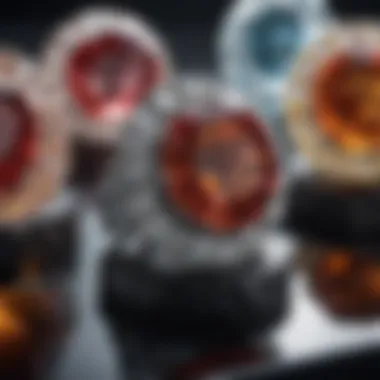
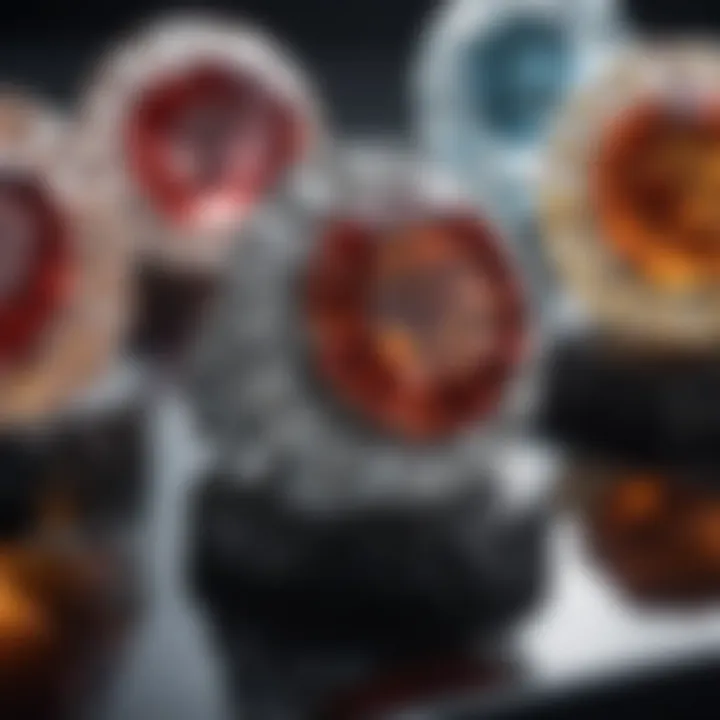
- Structured Learning: Books often present information sequentially, allowing learners to build a strong groundwork. Titles like "Gem Cutting: A Lapidary's Manual" by David C. McDonald lay out essential concepts clearly, making them digestible for novices.
- Visual Aids: Many well-done texts incorporate illustrations and charts, clarifying complex techniques and enabling learners to visualize the processes involved.
- Accessibility of Online Courses: Platforms like Coursera and Udemy offer a myriad of courses tailored to various skill levels. For instance, you can find a course specifically dedicated to the "Art of Faceting", designed to guide learners through core concepts at their own pace.
- Diverse Perspectives: Online courses frequently come with video demonstrations. These resources can present techniques from various experts, giving learners a broader understanding of the craft.
Investing time in books and online courses lays a solid groundwork and provides the theoretical backbone essential for practical application.
Workshops and Hands-On Experience
While books and videos can set you on the right path, the real magic happens when you dive into hands-on experiences. Workshops offer priceless opportunities for learners to engage directly with the tools of the trade. Consider the following aspects:
- Direct Guidance: Participants in workshops benefit from the mentorship of experienced faceters. This real-time feedback can significantly accelerate the learning curve. Many find that working alongside seasoned professionals highlights subtle nuances in technique that are not easily captured in print.
- Immediate Application: The beauty of workshops lies in their immersive nature. After learning a new concept or method from a book or course, you can immediately apply it. This repetitive practice fosters muscle memory, enhancing skill retention.
- Networking Opportunities: Joining workshops can also introduce you to like-minded individuals. Establishing contacts in the gem faceting community can offer insights, collaboration opportunities, and potential mentorship from established faceters.
- Experimentation: Workshops often provide access to a variety of tools and materials. This access encourages experimentation, allowing learners to find what techniques resonate best with their personal style and competency levels.
In short, merging theoretical knowledge with practical, hands-on experience is crucial in mastering the art of faceting. Each format provides distinct advantages that collectively contribute to a well-rounded education in gemology.
Gem Faceting: An Artistic Endeavor
The world of gem faceting is not just a mechanical process; it is an intricate blend of science and art. The importance of understanding gem faceting as an artistic endeavor is crucial for anyone getting into this craft. Faceting transforms raw gemstones into sparkling marvels, where every cut and angle is calculated to manipulate light, showcasing the stone’s natural beauty. This journey is imbued with creativity, technical skill, and a deep appreciation for each stone's inherent qualities.
The Aesthetics of Faceted Stones
The aesthetics of faceted stones hinge on how light interacts with the cuts made in the gemstone. Each facet is positioned precisely to enhance beauty and brilliance. For instance, consider the brilliant cut—known for its ability to reflect light in striking patterns. The angles are designed to allow maximum light entry and reflection, which causes a gem to appear lively and vivid.
Faceting is about more than just the technical execution; it reflects the faceter's vision and style. Think about how a skilled artisan can take a dull piece of rough quartz and turn it into a striking centerpiece for jewelry. This process not only increases the gem's market value but also embeds an emotional story within the stone.
Also, it's worth pondering the symbolism of color and shape in faceting. For example, a deep blue sapphire cut into an elegant oval shape might evoke a sense of tranquility and refinement. The emotional resonance of the gem becomes integral to its aesthetic appeal, affecting its desirability and market acceptance.
"Every cut tells a story, and every shape sings a tune that resonates with the viewer’s heart."
Creativity in Gem Faceting Designs
Creativity is a linchpin in gem faceting that distinguishes one faceter from another. Each artisan has the opportunity to imprint their personality on their designs. From choosing the cuts to selecting the total number of facets, creativity plays a pivotal role in shaping the end product.
Faceting is not a one-size-fits-all endeavor. Here's a few elements that can infuse creativity into designs:
- Experimentation with Shapes: Bouncing away from traditional rounds and ovals encourages innovation. For example, the trilliant cut, a triangular shape, can be a bold alternative.
- Custom Patterns: By blending techniques, like combining facets for different levels of depth and light, unique designs can emerge that stand out in a saturated market.
- Usage of Color: Understanding how colors reflect under different lights can inspire designs that shift from simplicity to extraordinarily unique pieces.
The mixture of techniques and personal flair creates a symphony within gem faceting. Hence, aspiring faceters should wholeheartedly embrace their imaginative impulses while remaining mindful of the technical precision required in the craft.
The Science Behind Faceting
Gem faceting is more than just a creative pursuit; it involves a scientific understanding that determines how a gemstone interacts with light. Grasping the principles of light behavior, and precision in crafting are imperative to produce stones that dazzle and captivate. This section explores how the nuances of physics and mathematic principles are intertwined in the art of gem faceting.
Understanding Light Interaction
When a gem is faceted, its interaction with light is the cornerstone of its visual appeal. Every cut, angle, and facet contributes to how light enters the stone, reflects off its surfaces, and ultimately exits. This sequence creates what is known as a gemstone’s brilliance, fire, and scintillation.
- Brilliance refers to the amount of light that reflects back to the observer's eye. A well-faceted gem can redirect a significant quantity of incoming light, causing it to shimmer brightly.
- Fire describes the spectral colors that appear when light is dispersed inside the gemstone. This is particularly true for diamonds, where the effects can be remarkably vivid.
- Scintillation is another key optical phenomenon, referring to the flashes of light one sees when moving a cut stone under a light source. This dance of light can create a stunning visual experience.
To achieve these effects, faceters carefully choose angles that optimize light reflection and refraction. Each gemstone has its own set of refractive properties, which means what works for one type may not work for another. For instance, the ideal cut for a round diamond is based on very specific angles, roughly 43 degrees for the pavilion where the light exits, to maximize its brilliance. On the other hand, colored gemstones like sapphires or rubies may require different approaches based on their unique characteristics.
"The right cut is like a dance – it must be perfectly in tune with the stone’s internal music of light."
Importance of Precision and Accuracy
Precision in gem faceting is not merely a preference but a necessity. Any small deviation from the established angles can lead to a loss of light performance, diminishing the overall allure of a stone. In this world, precision also translates into value; a meticulously faceted gem can command a significantly higher price than a poorly cut counterpart, even if they are of similar quality.
The intricacies involved include:
- Measurement Tools: Faceters rely heavily on tools like a protractor and a digital caliper to ensure that their measurements are spot on.
- Computer Aided Design (CAD): Some modern faceters utilize CAD software to plan and visualize cuts before making any physical modifications to the stone. This technology allows for an unparalleled level of accuracy, ensuring every facet is made to the exact specifications needed.
- Feedback Mechanisms: Some advanced faceting machines can provide real-time feedback, comparing desired angles with actual measurements while cutting, allowing gem cutters to make immediate adjustments.
In the world of gem faceting, every detail counts, as both light interaction and the precision of cuts come together to create gemstones that are not only valuable but also breathtakingly beautiful.
Future Trends in Gem Faceting
As gem faceting evolves, staying updated on future trends becomes vital for anyone passionate about gemstones. The landscape of gem faceting is shifting, not only due to technological advancements but also in response to societal changes. Understanding these trends can lead gem enthusiasts and professionals to be more informed in their practices while also enhancing their craft. This section digs into the two major trends shaping the future of gem faceting: the integration of technology and a commitment to sustainability.
Technology's Role in Faceting
The role of technology in gem faceting cannot be overstated. Modern faceting machines have transformed the way gemologists operate, allowing for precision that was once thought impossible. These machines utilize computer-aided design and laser technology, enabling faceters to create intricate designs with remarkable accuracy. The advent of digital tools not only enhances the efficiency of the process but also opens up new avenues for creativity.
For instance, tools like the Ultra Tec V5 or the Instant Faceting Machine have made a splash in the community. They allow users to visualize their cuts in real time, which significantly reduces the margin of error. Learning these tools is crucial for today’s students and enthusiasts.
Furthermore, there's a growing interest in 3D printing technologies that enable faceters to prototype designs before translating them into actual gemstones. This can save time and resources, boosting creativity in designs without the risk of wasting precious material.
To illustrate this, consider a faceter who wants to create a novel cut. By using a 3D printer, they can generate multiple prototypes and fine-tune the design until they achieve the ideal cut. This synergy of technology and artistry is setting a new standard in the industry.
"Embracing technology in gem faceting not only elevates the craft but also empowers faceters to push boundaries and redefine what is possible."
Sustainability in Gem Faceting Practices
As environmental awareness grows, sustainability has become a focal point across many industries, gem faceting included. This shift in focus requires faceters and gem enthusiasts alike to reconsider their practices and the origins of the materials they use. More and more, consumers are becoming socially conscious. They are inclined to support those who adhere to ethical practices when it comes to sourcing and processing gemstones.
The use of recycled materials is on the rise, encouraging gem enthusiasts to rethink their supply chains. Rather than solely relying on newly mined gems, many are now exploring the benefits of using reclaimed gemstones. This practice not only reduces environmental impact but also supports fair trade initiatives.
In addition, eco-friendly polishing and cutting methods are gaining traction. For example, some companies are developing new solutions to replace traditional chemical polishing agents, making processes less harmful to the environment without sacrificing quality. Faceters committed to sustainable practices often find that their dedication resonates with customers, bolstering their brand’s reputation.
To sum it up, both technology and sustainability are carving distinct paths collectively shaping the future of gem faceting. By embracing these trends, one can stay relevant and act responsibly in the ever-evolving world of gemstones.
Ethical Considerations in Gem Faceting
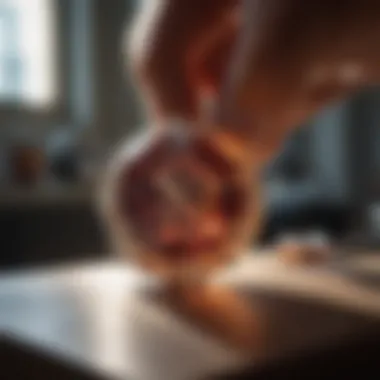
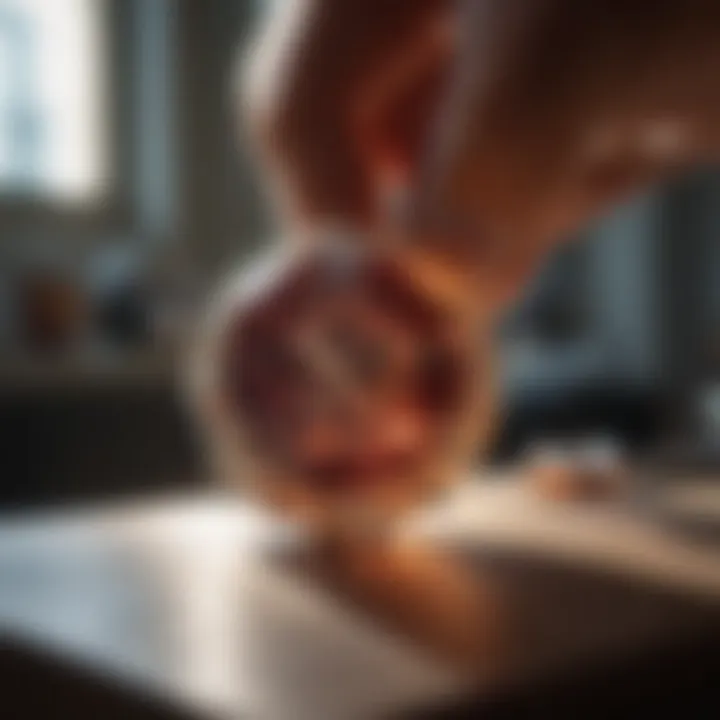
In the intricate tapestry of gem faceting, the ethical dimensions are woven in as deeply as the cuts and facets themselves. As the public becomes more aware of the origins and impact of their purchases, gemological practices must reconcile artistry with responsibility. As we journey through the ethical landscape, we explore critical dimensions – from sourcing practices to the environmental toll – that every facet of this craft should consider.
Fair Trade Practices in Gem Sourcing
Fair trade in gem sourcing is more than just a buzzword; it’s about ensuring that those who extract these precious stones get a fair chance at a livelihood. Sourcing gems through fair trade channels can mean the difference between impoverished workers and sustainable communities.
A few essential elements underpin fair trade practices:
- Transparence: Knowing exactly where the stones come from and how they are mined is crucial.
- Equitable compensation: Miners should receive a wage that aligns with their labor and environmental demands.
- Support for communities: Funds generated should be funneled back into the mining regions for education, healthcare, and infrastructure.
By choosing fair trade gems, buyers are not only acquiring beautiful pieces but also contributing to communities that work hard to bring beauty to the market. This ethical approach shields consumers from the guilt that can accompany purchases made from exploitative sources.
Environmental Impact of Gem Faceting
The environmental concerns linked to gem faceting are as sparkling as the gemstones themselves. The extraction and processing of gems often leave a lasting mark on the landscape, affecting ecosystems and local communities. Here are some considerations:
- Mining Techniques: Traditional mining can lead to extensive land degradation. Employing responsible methods minimizes negative impacts and promotes ecological balance.
- Water Usage: The faceting process consumes a significant amount of water, often leading to scarcity in nearby areas. Using water-efficient practices can alleviate some of this stress.
- Waste Management: During faceting, by-products and waste materials contribute to pollution. Establishing waste recycling programs can lessen the overall environmental burden.
"The true gem of nature is the environment from which our stones are derived; protecting it is vital for the future of gem faceting."
In light of these factors, sustainable practices not only protect the planet but also enhance the integrity of the faceting craft itself, ensuring that it can thrive without leaving destruction in its wake. As gemstone enthusiasts and participants in this unique art, understanding the ethical implications can elevate our appreciation for the stones we cherish.
Community and Network of Faceters
The journey of a faceter isn’t just about mastering the tools or techniques; it's also about building a community. The world of gem faceting is connected by threads of shared experiences, mentorship, and collaboration. Figure it this way: when you enter this craft, you don’t just become a lone wolf; rather, you join a tight-knit circle where knowledge flows like water, enriching the practice for everyone involved.
Having a community is not an optional extra. It serves as the backbone for personal and professional growth. The benefits that come from engaging with fellow faceters include sharing tips and tricks, troubleshooting challenges, and exploring novel techniques. Imagine being stuck on a cut; a quick chat with someone who has faced a similar issue could save you both time and frustration. Not only does this foster a culture of learning, but it also sparks creativity. Collaboration can lead to innovative ideas and approaches that might not happen when working in isolation.
Furthermore, being part of a network keeps you updated with the latest trends and technologies in faceting. Organizations often organize seminars, workshops, and online forums where members can exchange ideas and stay abreast of advancements in tools and materials. This level of engagement enhances one’s skills and also positions members to make informed decisions about their craft.
In sum, a community of faceters is integral to one’s journey in this art form. Whether a novice or a seasoned expert, tapping into this network enriches the experience, paving the path for continuous learning and camaraderie.
Joining Faceting Organizations
When you decide to dive into the realm of gem faceting seriously, joining a faceting organization is a wise step. These groups offer a treasure trove of resources and opportunities that are crucial for anyone keen on advancing their skills. They serve as a hub where enthusiasts converge, allowing newcomers to benefit from the wisdom of seasoned professionals.
Participation in an organization often comes with a host of advantages:
- Access to Educational Resources: Many organizations provide access to specialized classes, tutorials, and workshops that are not available elsewhere. These resources can help refine your techniques and broaden your understanding of faceting.
- Networking Opportunities: Attending meetings, events, or exhibitions hosted by these organizations allows for face-to-face networking, which can lead to mentorship opportunities and lasting friendships.
- Sense of Belonging: Being part of a community can make a significant difference in your pursuit. Feeling connected with like-minded individuals can be motivating, facilitating a deeper commitment to your gem faceting journey.
To find an organization that fits your needs, look for local or national groups such as the United States Faceting Guild or regional gemstone associations. Engaging with these organizations elevates not only your artistry but also your connection within the broader face of gemology.
Participating in Faceting Competitions
Competing in faceting events can be a game changer for a gem faceter. Such competitions serve as an arena where artisans can showcase their skills and innovative designs. While the idea of competition may induce a bit of nerves, it can also act as a catalyst for improvement.
Engaging in these contests offers several notable benefits:
- Skill Enhancement: The pressure to perform well encourages competitors to refine their techniques and pay closer attention to detail. This heightened focus fosters technical growth and artistic flair.
- Feedback from Experts: Competitions typically include judges who are often established professionals in the field. Their critiques can prove invaluable, offering insights that you wouldn’t get elsewhere.
- Building Reputation: Securing an award—no matter how big or small—can bolster your reputation within the community. This enhanced visibility opens doors to potential networking opportunities, collaborations, and even client inquiries.
Many events also feature exhibition avenues, providing a platform for participants to display their creations. This visibility can promote not only your work but also raise awareness of gemstone artistry in general.
Gem Faceting and Cultural Significance
Gem faceting is not merely a mechanical process; it carries immense cultural weight and significance across various societies. From ancient civilizations to modern communities, gemstones have been symbols of power, beauty, and even spiritual connection. The act of faceting transforms rough stones into dazzling artifacts, serving as testaments to human creativity and our long-standing fascination with the earth's treasures.
Historical Connections to Gemstone Usage
Historically, gemstones have played pivotal roles in various cultures. They have been used in religious rituals, healing practices, and royal adornments. For instance, in ancient Egypt, turquoise and lapis lazuli were believed to possess protective properties, leading to their common use in funerary masks and jewelry. In India, gemstones like rubies and sapphires have been associated with both status and auspiciousness, often incorporated into jewelry for weddings and important ceremonies.
Many societies regarded certain stones as sacred, linking them to deities or significant events in history. The connection between faceted stones and their cultural meanings adds layers of depth to the craft. Faceting not only preserves these meanings but enhances them, bringing forth the brilliance and clarity that resonate with the values of the culture who cherishes them. This interplay of art and culture elevates faceting beyond simple craftsmanship, embedding it in the very fabric of cultural identity.
Faceting in Different Cultures
Different cultures exhibit unique approaches to gemstone faceting, shaped by local traditions, beliefs, and natural resources. In Asia, for instance, the use of intricate patterns and cuts in gemstones is often reflective of ancient philosophies, such as Feng Shui in China, where certain stones are cut and positioned to promote positive energy. Such cultural insights influence not only the choice of gemstones but also the techniques employed in faceting.
Conversely, Western cultures have historically focused on symmetry and brilliance in their faceting styles, driven by a quest for aesthetic appeal and market demands. This divergence is particularly notable in the way diamonds are faceted for optimal sparkle, often using techniques that maximize light reflection.
"The craft of gem faceting, while technical in its execution, becomes a cultural dialogue when one considers the stories, beliefs, and historical connections that underpin each cut."
In contemporary settings, the global exchange of faceting styles has allowed for a blending of traditions, enriching the field as a whole. Artisans today draw inspiration from various cultural heritages, creating designs that resonate with a wide audience. The significance of gem faceting thus extends beyond personal adornment; it is a celebration of cultural diversity, an expression of identity, and an ongoing evolution of artistic expression rooted in history.
The End and Key Takeaways
Gem faceting, an art form that combines technical skill with creativity, has an undeniable charm for many. This article has navigated through the various facets—no pun intended—of gem faceting classes and techniques. The importance of this exploration lies not just in learning how to cut stones, but in appreciating the intricate processes that enhance their beauty and value.
Recap of Faceting Techniques and Classes
Throughout this guide, we have covered essential facets of learning gem faceting. To recap:
- Basic Cuts: We explored classic cuts such as round, oval, and princess, explaining how each shape interacts with light and affects the overall aesthetics of the gem.
- Advanced Techniques: Moving beyond the basics, we discussed advanced methods including faceting intricate designs and multi-faceted cuts. These techniques require not only practice but also an understanding of crystal structures and optical properties.
- Types of Classes: The landscape of classes available ranges from beginner workshops designed to give newcomers a solid foundation to specialized courses for seasoned faceters looking to hone their skills further. Each level offers unique insights and techniques that build on previous knowledge.
For anyone serious about gemology, engaging in practical classes can make a world of difference. These experiences not only provide hands-on practice but also an opportunity to connect with experienced faceters and like-minded peers.
The Ongoing Journey of a Faceter
Becoming a skilled faceter is not a one-time endeavor; it’s a continuous journey. The world of gem faceting is ever-evolving, influenced by advances in technology, changing market demands, and new styles.
- Lifelong Learning: Just like any craft, gem faceting requires ongoing education. New techniques flood in, and keeping abreast of these can elevate one’s artistry and craftsmanship.
- Community Engagement: Joining forums, attending competitions, and participating in workshops fosters a sense of camaraderie. Like any other artisan community, the support and exchange of ideas among faceters are invaluable.
- Personal Growth: Each stone worked on becomes a stepping stone in one’s development. Success and failure alike contribute to the learning experience, leaving room for innovation and personal style.
"The journey of a faceter is marked not just by the gems crafted but by the skills honed and the community built along the way."
Final Thoughts
In summary, exploring gem faceting classes empowers enthusiasts, collectors, and professionals alike. This knowledge becomes the bedrock of expertise that can transform simple stones into exquisite masterpieces. As one delves deeper into this craft, they not only improve their techniques but also deepen their connection to the beauty that gems possess.



